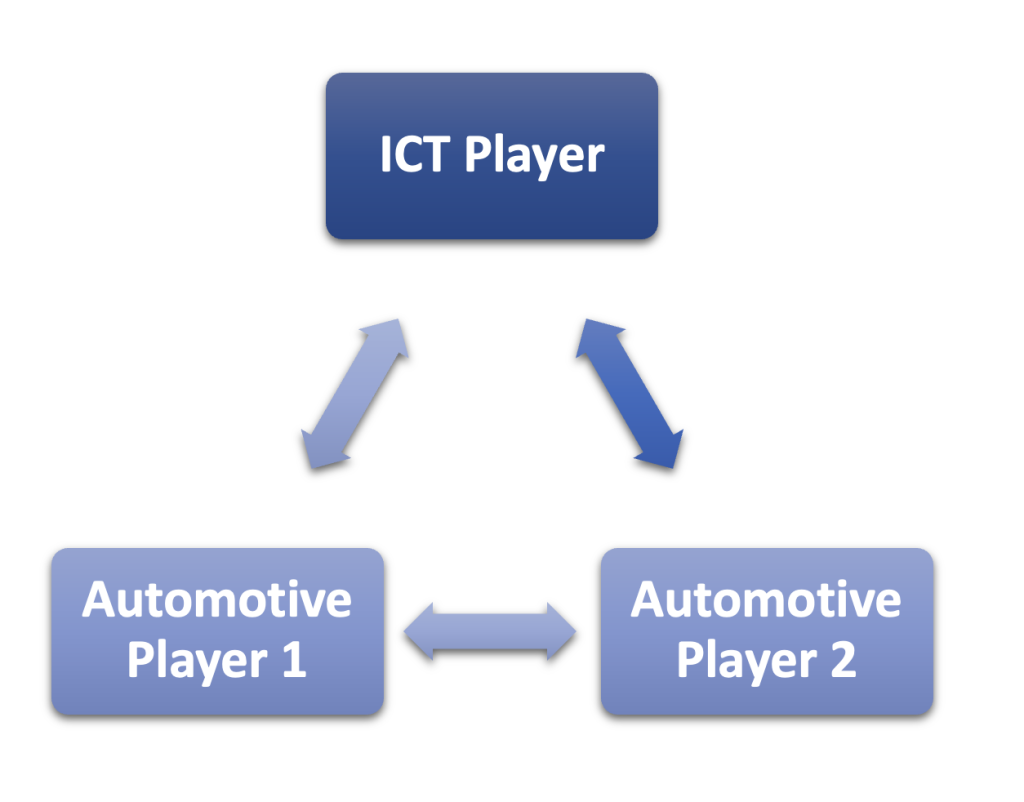“In the long history of humankind (and animal kind, too), those who learned to collaborate and improvise most effectively have prevailed.” – Charles Darwin.
 Collaboration has invariably helped people to maneuver the most significant challenges and hurdles. Like all other human accomplishments, technology players have collaborated and enforced methodologies to avert any obstacles faced while creating innovation-driven sustainable businesses, to enable technology-driven societies. While innovation can be both an individual and collective endeavor, shaping the final consumer product/service demands collaborative innovation and coordinated policies and frameworks.
Collaboration has invariably helped people to maneuver the most significant challenges and hurdles. Like all other human accomplishments, technology players have collaborated and enforced methodologies to avert any obstacles faced while creating innovation-driven sustainable businesses, to enable technology-driven societies. While innovation can be both an individual and collective endeavor, shaping the final consumer product/service demands collaborative innovation and coordinated policies and frameworks.
Evolution of Patents and Patenting
What we call patents were known as “royal grants of industrial monopolies” in the fifteenth century. Patents were first given their present status as “a legal right to property in a novel, mechanical or scientific invention” only in the late eighteenth century. Since then, patenting and patent enforcement processes have witnessed tremendous alterations at multiple intervals and levels.
In this evolution process, multiple strategies and frameworks were formed to streamline the development of modern-day technologies and the resultant end product. Such frameworks include Standards Development Organizations (SSO or SDO), patent pools, and many other consortiums and forums. These frameworks were established to foster the integration of highly distributed IP assets for the final adoption and harvesting of end technology.
SSOs focus on developing, publishing, or disseminating technical standards using a consensus-based standard development process. These include bodies like ETSI, ITU, 3GPP, amongst others. Similarly, a patent pool refers to a consortium of two or more patent owners to license one or more patents to one another or to third parties. These include entities like Avanci, MPEGLA, Marconi, among others, and in essence, has been created to avoid crushing patent lawsuits. For example, the “Sewing Machine Combination” of 1856 is regarded as the first modern patent pool in the United States and was created for the same infamous reasons.
To cater to the challenges from Patent Assertion Entities (PAEs or Patent trolls), defensive patent aggregators were formed, with the likes of RPX and AST, which have helped member organizations to avert frivolous assertions from such entities.
The discussion above emphasizes the need for collaboration to introduce technological advances. These partnerships have consistently paved the way towards continued innovation. However, many opponents argue that there are negative effects of these collaborations and their underlying frameworks.
Need For Deeper Collaboration
All the listed consortiums and forums have end-stage utility to ensure smoother technology adoption. However, with the proliferation of technologies across industry sectors, there’s a need for deeper collaboration, which come into action at the R&D level and prevent lawsuits and technology stagnation.
To understand the need for deeper collaboration, let’s understand this from the perspective of information and communications technology (ICT) proliferation, which exists in almost every industry sector.
As illustrated in the figure below, there are a couple of probable collaboration schemes possible. Instead of working in silos, any possible collaboration from the set of probabilities would have its set of pros and cons.

Figure: Probable industry collaboration
Let us assume the incorporated ICT technologies in the end automotive product don’t fall under the competitive area for either of the automotive players. Among one of those possibilities, imagine a scenario wherein the two automotive players initiate coordinated research into enabling ICT technologies to alleviate their absolute reliance on any ICT player, while continuing independent research in their mainstream industry segments. This strategy would help them merge their talent pool towards collaboratively building ICT technologies and leverage their core expertise to build breakthrough innovations in their competitive area. Given the current cross-domain applicability of technologies, this case scenario reiterates the scope for such a possibility in almost all industry sectors.
What are the Benefits?
Why would companies take initiatives to execute collaborative research and to develop collective patent portfolios to secure their market dominance? Her are a few of the benefits:
- Standardization from the beginning
- Effective adoption of the technology
- Patent pools in each industry streamlining technology/patent licensing
- Win-win situation for businesses and consumers
To achieve such strategic collaborations, industry players need to establish collaborative R&D frameworks and lay the foundation for the next generation of patenting, with the hope of building a better future for all.
Image Source: Deposit Photos
Copyright:lucadp
Image ID:21468909

![[IPWatchdog Logo]](https://ipwatchdog.com/wp-content/themes/IPWatchdog%20-%202023/assets/images/temp/logo-small@2x.png)

![[Advertisement]](https://ipwatchdog.com/wp-content/uploads/2024/04/Patent-Litigation-Masters-2024-sidebar-early-bird-ends-Apr-21-last-chance-700x500-1.jpg)

![[Advertisement]](https://ipwatchdog.com/wp-content/uploads/2021/12/WEBINAR-336-x-280-px.png)
![[Advertisement]](https://ipwatchdog.com/wp-content/uploads/2021/12/2021-Patent-Practice-on-Demand-recorded-Feb-2021-336-x-280.jpg)
![[Advertisement]](https://ipwatchdog.com/wp-content/uploads/2021/12/Ad-4-The-Invent-Patent-System™.png)







Join the Discussion
8 comments so far.
Anon
December 21, 2021 09:57 amUpon reflection (and contemplating the comments provided), I withdraw my advice that the article should be taken as a type of “intro” piece.
The article should be disregarded.
Pro Say
December 19, 2021 07:26 pm“To cater to the challenges from Patent Assertion Entities (PAEs or Patent trolls), defensive patent aggregators were formed, with the likes of RPX and AST, which have helped member organizations to avert frivolous assertions from such entities.”
“Defensive patent aggregators were formed, with the likes of RPX and AST, which have helped member organizations get away with paying only pennies-on-the-dollar for the innovations of others.”
There. Fixed.
Put down your Big Tech pom-poms.
Moderate Centrist Independent
December 18, 2021 06:34 pmAnother piece of fluff from Sagacious IP.
Lab Jedor
December 18, 2021 02:38 pmWhen industries fail (which they do all the time) it is the individual entrepreneur, who is often an independent inventor, who takes over. They become the new big king/queen and the cycle starts all over again. We know this and we can predict it. Even better, the new technology kings/queens know it and they try to prevent it at any cost. Despite this knowledge we do not spend time, effort, policies and money to support the individual inventor. In fact, we do whatever possible to limit and prevent the vibrancy and success of independent inventors to shore up the incumbents (who for now have the money).
To dress up this known fact as some novel Collaborative Patenting and as a variant of a barely veiled protection against “trolls” is pretty much ridiculous.
Any foundation of a patent system (be it modern or Constitutional) should advance and promote doing inventions and benefit from it, by anyone. A “modern” patent system as we have now seems only to produce worthless paper products.
A fact recognized by the USPTO as it proposes to forgo a printed version of a patent when it issues. I believe that to be a correct recognition by the PTO of the value of a patent today: not (even) worth the paper it is printed on.
Anon
December 18, 2021 10:43 amIt helps to look at this article as a type of “intro” piece (as opposed to be being aimed at anyone with more than a passing knowledge of patent law or innovation protection history).
Lab Jedor
December 18, 2021 10:39 am“industry players need to establish collaborative R&D frameworks and lay the foundation for the next generation of patenting”
By now we pretty much know how the efforts by industry “to lay the foundation of the next generation of patenting” has worked out. It has killed the Goose that Laid the Golden Eggs. It has demolished a patent system that was the gold standard and the envy of the world. It has our rivals watching with amazement how we deliberately deconstruct a key advantage in an increasingly competitive innovation environment. And why? All to maintain and cement the position of Big Tech.
“Never interfere with an enemy in the process of destroying himself” Napoleon famously said. I don’t think industry needs any further advice and stimulus to suppress competitive R&D by way of the patent system. But thanks anyway.